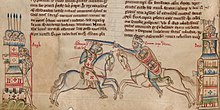Edmund II (England)

Edmund II , called "Iron Side" ( Ironside ), from the House of Wessex (* around 989 in Wessex ; † November 30, 1016 ), son of Æthelred and his first wife Ælfgifu of York, was King of England in 1016 for a short time . His wife was Ealdgyth.
When his father died during the siege of London by Canute the Great in April 1016, the Londoners proclaimed him successor and king over England. Between the now two English kings Edmund and Knut, there were some skirmishes and finally the decisive battle of Assandun , in the course of which some English princes fell away from Edmund and his army was crushed. Nevertheless, Knut sought a balance with his opponent, so that England was divided. Edmund became King of Wessex, Canute ruled over the rest. Part of the agreement was that if one of the two kings died, the other would take over rule over the entire empire. Edmund died just a month later, and Wessex submitted to Knut.
Although Edmund could hardly exercise his rule, he inherited the claim to the throne. His son Edward died in 1057. His son Edgar Ætheling was therefore the new heir to the throne from an Anglo-Saxon point of view. He did not come to power, but his niece Mathilde , daughter of Edmund II's granddaughter Margaret , became the ancestor of the future English kings through her marriage to Henry I , son of William the Conqueror , and thus united the Saxon and Norman lines . About Margaret and her marriage to Malcolm III. of Scotland Edmund is also the progenitor of all Scottish kings from Edgar on.
See also
swell
- anonymous, Anglo-Saxon Chronicle
- Symeon of Durham , Historia regum Anglorum et Dacorum
- Snorri Sturluson , Heimskringla
Web links
- The Anglo-Saxon Chronicle in Project Gutenberg (English)
- Symeon von Durham , Translator: J. Stevenson: The Historical Works of Simeon of Durham . In: Church Historians of England, volume III, part II . Seeley's. 1855. Retrieved October 3, 2009.
- The Online Medival & Classic Library: Heimskringla or The Chronicle of the Kings of Norway
| predecessor | Office | successor |
|---|---|---|
| Æthelred |
King of England 1016 |
Knut |
| personal data | |
|---|---|
| SURNAME | Edmund II |
| ALTERNATIVE NAMES | Edmund II. Ironside |
| BRIEF DESCRIPTION | King of England (1016) |
| DATE OF BIRTH | around 989 |
| PLACE OF BIRTH | Wessex , England |
| DATE OF DEATH | November 30, 1016 |
